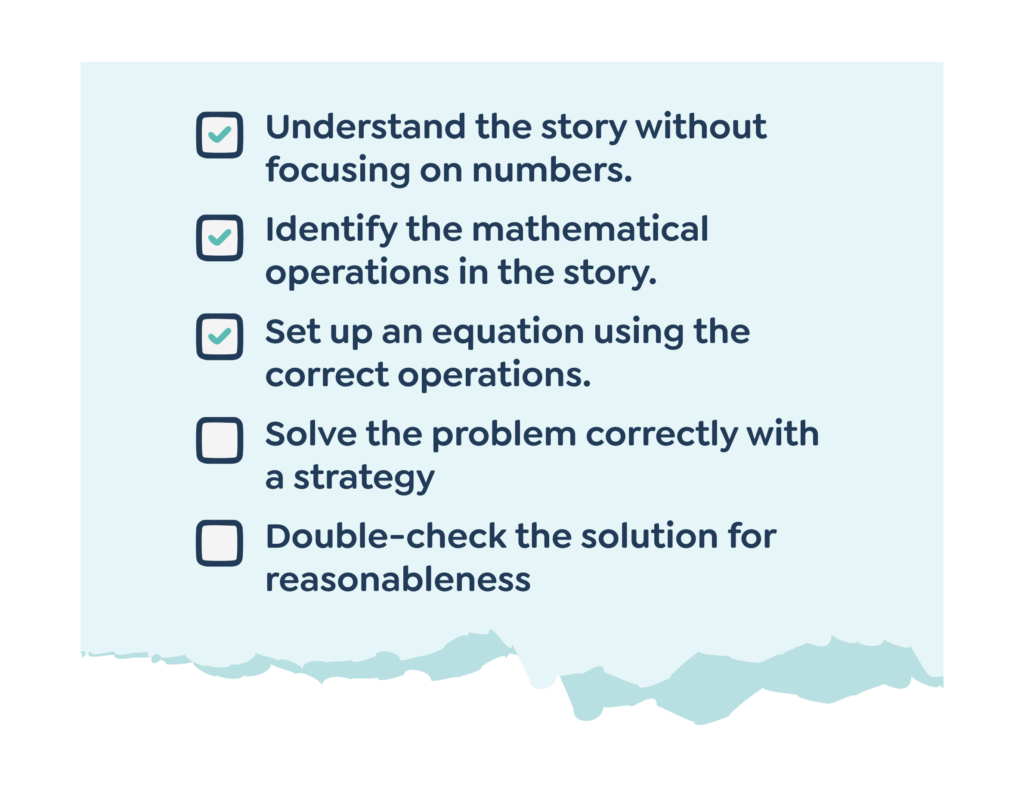Problem-solving exists as the most complex and targeted area in elementary math. Why? Because as students progress through grades, the word problems become more complex and the misconceptions within students amplify. By co-constructing success criteria, elementary students often benefit from clear steps that guide them through the process, where the breakdown is, and why each step is important.
In this blog, we’ll explore how teachers can guide students to co-create success criteria for word problems and how these criteria can be used in the goal-setting process.
1. Start with a Numberless Word Problem
Begin by introducing a word problem, but remove the numbers. This encourages students to focus on understanding the problem rather than immediately trying to calculate an answer.
When recently collaborating with a 4th-grade Impact Team, we analyzed student work and co-created the process to understand a word problem. Here is what we came up with:
3 Reads of Understanding a Word Problem:
- Read the problem to imagine (cover all numbers with fingers/dots)
- Read the problem to understand (circle what we know)
- Read the problem to solve (underline what we need to figure out)
Other Questions to Ask:
- What’s happening in this story?
- What actions are being described (e.g., giving away, buying more)?
- What do we need to figure out?

Example: A boy has some pencils. Later, he buys more pencils. How many pencils does he have now?
Visual Idea: Use a simple Start, Change, Result Story Map or sequence of images to help students visualize the events, such as a picture of a boy buying more pencils.
Success Criteria Step:
1. Understand the story without focusing on numbers.
2. Identify the Key Operations
Once students understand the story, have them identify the mathematical operations involved. By this point, they should be able to recognize what’s happening mathematically (e.g., addition, subtraction).
Questions to Ask:
- What “action” does buying more pencils describe?
Visual Idea: Use operation symbols (+, -, =) to help students match the words in the problem with the math operations. Place the symbols next to parts of the problem that signal these operations.
Don’t Fall For the “Key Word” Trap!
It is critical to focus on the action of the problem instead of keywords as they tend to set up a trap for our problem solvers. Shametria Routt Banks shares a great example of a “keyword fail” in her blog:
Consider the following problem: Julie left $9 on the table. Her brother left $6 on the table. How much money was left on the table? The use of the word “left” might indicate to some that the solution to this problem is obtained by subtracting; however, this is an addition situation because two quantities are being joined together.
Success Criteria Step:
2. Identify the mathematical operations in the story.
3. Write the Equation
After identifying the operations, co-construct how to represent the situation with an equation using placeholders for the numbers.
Questions to Ask:
- How can we set up an equation to represent the problem?
- What operations come first, second, etc.?
Visual Idea: Use an empty equation template that students can fill in as they get the information, making it clear how the operations fit together.
Beware of Multiple Access Points
Although co-constructing in problem-solving can seem like a step-by-step guide, it is important to relay to students that there are always multiple ways to determine an answer. Some students may visualize a pictorial model first while others may quick-jot an equation first. You may also have students that represent the story with different equations from the same fact family. These are all wonderful opportunities for math talks with your students.
Success Criteria Step:
3. Set up an equation using the correct operations.
4. Solve the Problem
Now that students have a clear understanding of the structure, they are ready to solve using numbers.
Questions to Ask:
- What numbers should we subtract/add?
- Which strategy is the most efficient for this problem?
- Which strategy will you try today?
Visual Idea: get students into the habit of drawing a line down the middle of their workspace so that they preemptively know to check with another strategy
Build a Strategy Bank With Your Students
Traditionally, teachers have modeled strategies for students to master. However, this is a great segway for students to showcase their exemplars and highlight the different ways to solve them. In doing this regularly, teachers have built-in opportunities to build a strategy bank for students to choose from the next time they tackle a word problem.
Success Criteria Step:
4. Solve the problem correctly with a strategy
5. Double-Check Your Work
The final step in co-constructing success criteria is teaching students to check their work. This ensures accuracy and reinforces their understanding.
Questions to Ask:
- Did we add/subtract correctly?
- Did we check with a second strategy?
- Does our final answer make sense with the story?
- Is our answer reasonable?
Success Criteria Step:
5. Double-check the solution for reasonableness
Example of Co-Constructed Success Criteria
Here’s what a final co-constructed success criteria list might look like for solving a math word problem as the language and complexity may vary by each grade’s standards:

How to Connect Success Criteria with Goal Setting
By co-constructing success criteria with students, you empower learners to take ownership of their growth. You may notice the checkboxes in the final success criteria above, as they indicate that teachers and students can use them for feedback and goal setting, clarifying their strengths and next steps. It really is as simple as turning them into a checklist!
To paraphrase a young student, without success criteria, “I may view myself as a learner who always gets word problems wrong.” But with the example above, “I can brag about how I understand word problems and which operation to use. My teacher, family, and I also now know that my learning goal is to practice accuracy in strategies and that I am on my way to mastering that goal!”



